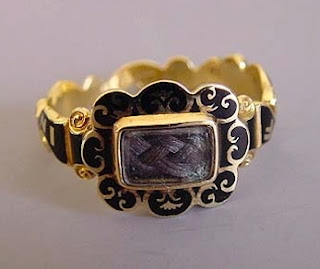One of the reasons I got into jewelry is just that, that jewelry is so personable, every piece of jewelry has it's own story. In my jewelry, one of the things I design and make is up-cycled vintage jewelry and I wish these vintage pieces could talk like the pearls, because they must have some stories to tell us.
 |
| Mourning Brooch, From Europe Or The U.S.A., Ca. 1845 |
Death was much more accepted during these times, as it happened so much more then it does today, with Western Medicine and much better hygiene. Mourning jewelry was quite common.
It is symbolic that it was Queen Victoria herself that made hair jewelry so very popular. When Prince Albert died in 1861, (her husband who was also her first cousin...) she wore a brooch with his hair over her heart and did so until the day she died. She also gave the Empress Eugenie of France a bracelet made from her hair, as a gift. All this made mourning jewelry and jewelry with hair very popular.
 |
| A Gold And Enamel Mourning Ring, Ca. 1855 |
Queen Victoria continued mourning in her private life. She wore black clothes only as well as only black mourning jewelry. During these Victorian times, when a mother would lose one or more of her children, she would wear the hair of her children, braided and under glass, as a ring, a brooch, a pendant or a bracelet. The same for women who lost their husbands, usually in battle.
However, hair jewelry should not be confused with mourning jewelry only. Hair jewelry has been with us from the beginning of time. In an era before photography, hair was the most personal token one could bestow on a loved one who may be traveling far away. Eventually these locks of love were set into rings or lockets and such.
Mourning Jewelry or fashion statement, I can't think of a more personable piece of jewelry then one made out of the hair of a loved one.
 | ||
| An Example Of Table Braided Hair Jewelry, Popular During Victorian Times. |
Reference: Wikipedia and Grand Oak Plantation.




